MBA402 Kaplan: Sustainability Assessment Report - Timberwell Case
VerifiedAdded on 2023/03/30
|12
|2416
|236
Report
AI Summary
This report provides a comprehensive sustainability assessment of Timberwell Constructions, utilizing the GRI (Global Reporting Initiative) Reporting Standards. It delves into economic, environmental, and social sustainability issues faced by the company. Regarding economic sustainability, the report analyzes the financial implications of climate change, instances of corruption, and legal actions related to anti-competitive behavior. For environmental sustainability, it examines energy consumption, impacts on biodiversity (specifically concerning rare wallum sedge frogs), and non-compliance with environmental laws. In terms of social sustainability, the report addresses employee hiring and attrition rates, age-based discrimination complaints, and community engagement programs. The assessment highlights the challenges Timberwell Constructions faces and the policy changes it is implementing to address these sustainability issues, ultimately affecting its operations, revenue, and costs.
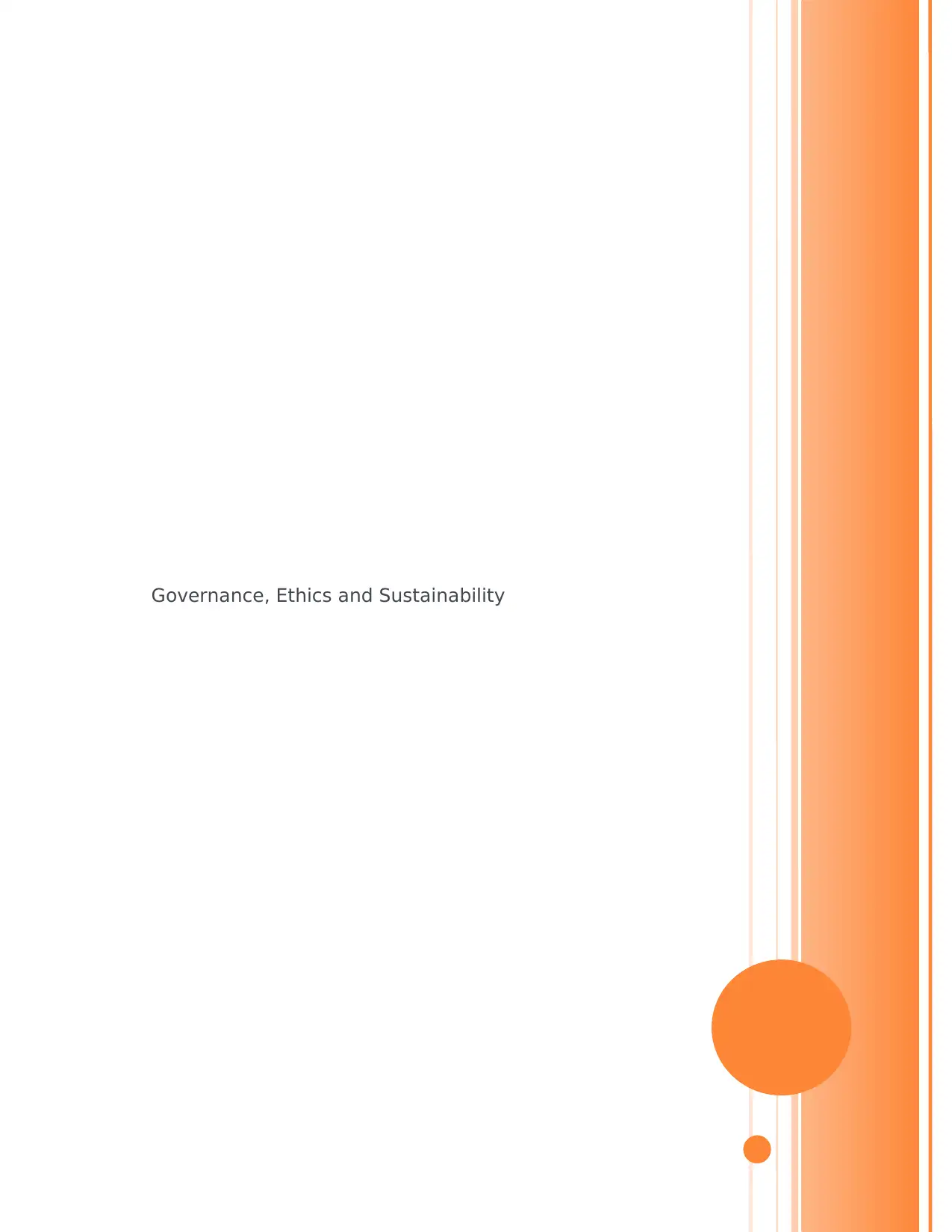
Governance, Ethics and Sustainability
Paraphrase This Document
Need a fresh take? Get an instant paraphrase of this document with our AI Paraphraser

INTRODUCTION
While taking sustainability decisions, there are three factors which are
necessary to be taken into consideration by companies: “economic,
environmental and social sustainability”. A balance between these
factors provides a competitive advantage to companies by ensuring
that they focus on the interest of a diverse range of stakeholders (Mota
et al., 2015). In order to achieve this goal, companies have to make
sure that they prepare sustainability records and issue sustainability
report on a periodic basis which allows them to maintain transparency
in their operations and increase accountability of the management
(Longoni and Cagliano, 2015). For effective sustainability reporting and
recording, companies can use GRI (“the Global Reporting Initiative”)
Reporting Standards which are referred to international principles that
assist in governing the recording and reporting practices of companies
on a global stage (Global Reporting, 2019). The provisions given under
these principles are interrelated which ensure “best practices” for
reporting practices regarding sustainability practices of companies and
their impact. The aim of this report is to analyse the case of
“Timberwell Constructions” in order to use “GRI Reporting Standards”
to prepare a “sustainability assessment report” for the organisation.
1
While taking sustainability decisions, there are three factors which are
necessary to be taken into consideration by companies: “economic,
environmental and social sustainability”. A balance between these
factors provides a competitive advantage to companies by ensuring
that they focus on the interest of a diverse range of stakeholders (Mota
et al., 2015). In order to achieve this goal, companies have to make
sure that they prepare sustainability records and issue sustainability
report on a periodic basis which allows them to maintain transparency
in their operations and increase accountability of the management
(Longoni and Cagliano, 2015). For effective sustainability reporting and
recording, companies can use GRI (“the Global Reporting Initiative”)
Reporting Standards which are referred to international principles that
assist in governing the recording and reporting practices of companies
on a global stage (Global Reporting, 2019). The provisions given under
these principles are interrelated which ensure “best practices” for
reporting practices regarding sustainability practices of companies and
their impact. The aim of this report is to analyse the case of
“Timberwell Constructions” in order to use “GRI Reporting Standards”
to prepare a “sustainability assessment report” for the organisation.
1
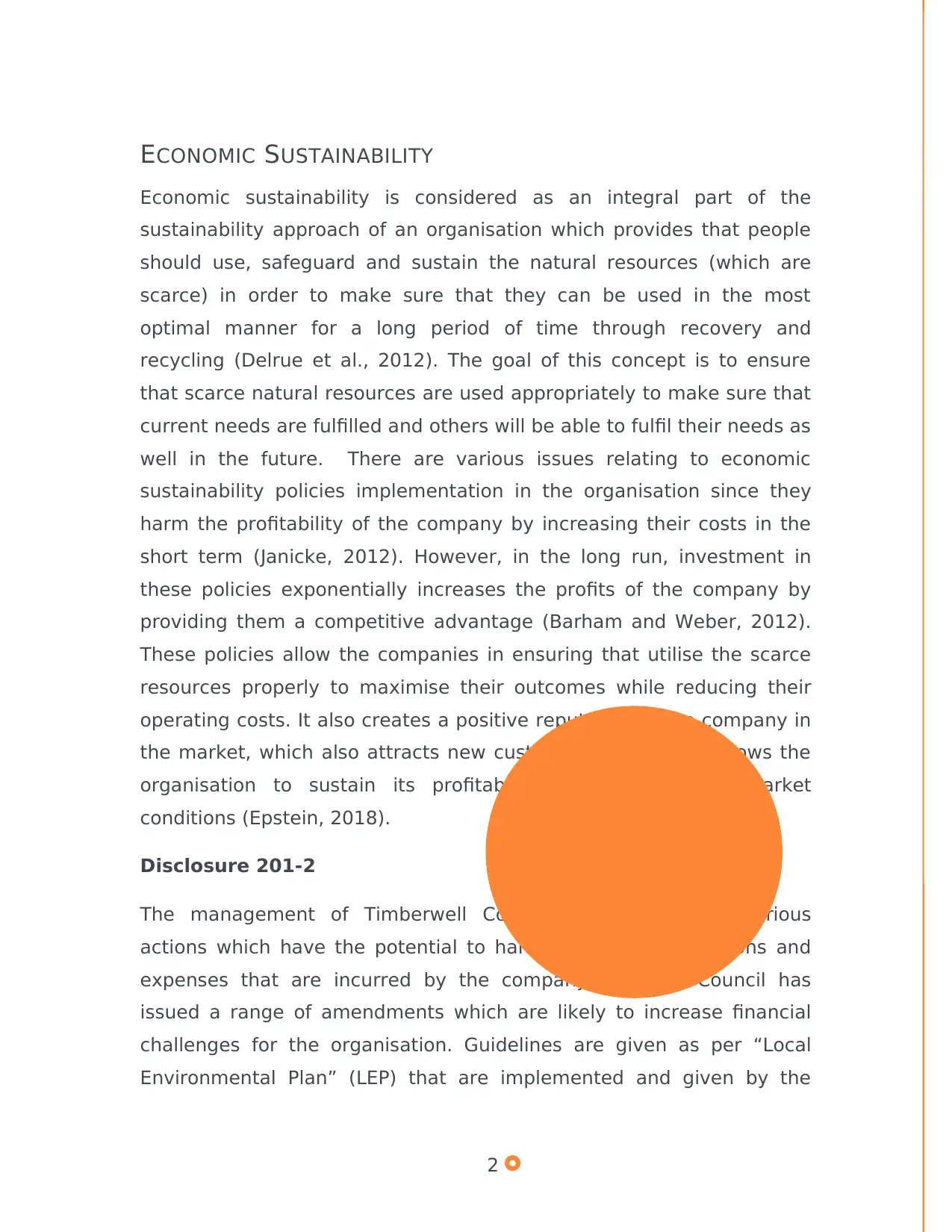
ECONOMIC SUSTAINABILITY
Economic sustainability is considered as an integral part of the
sustainability approach of an organisation which provides that people
should use, safeguard and sustain the natural resources (which are
scarce) in order to make sure that they can be used in the most
optimal manner for a long period of time through recovery and
recycling (Delrue et al., 2012). The goal of this concept is to ensure
that scarce natural resources are used appropriately to make sure that
current needs are fulfilled and others will be able to fulfil their needs as
well in the future. There are various issues relating to economic
sustainability policies implementation in the organisation since they
harm the profitability of the company by increasing their costs in the
short term (Janicke, 2012). However, in the long run, investment in
these policies exponentially increases the profits of the company by
providing them a competitive advantage (Barham and Weber, 2012).
These policies allow the companies in ensuring that utilise the scarce
resources properly to maximise their outcomes while reducing their
operating costs. It also creates a positive reputation of the company in
the market, which also attracts new customers, and it also allows the
organisation to sustain its profitability even in adverse market
conditions (Epstein, 2018).
Disclosure 201-2
The management of Timberwell Constructions has taken various
actions which have the potential to harm the profits, operations and
expenses that are incurred by the company. Stanwell Council has
issued a range of amendments which are likely to increase financial
challenges for the organisation. Guidelines are given as per “Local
Environmental Plan” (LEP) that are implemented and given by the
2
Economic sustainability is considered as an integral part of the
sustainability approach of an organisation which provides that people
should use, safeguard and sustain the natural resources (which are
scarce) in order to make sure that they can be used in the most
optimal manner for a long period of time through recovery and
recycling (Delrue et al., 2012). The goal of this concept is to ensure
that scarce natural resources are used appropriately to make sure that
current needs are fulfilled and others will be able to fulfil their needs as
well in the future. There are various issues relating to economic
sustainability policies implementation in the organisation since they
harm the profitability of the company by increasing their costs in the
short term (Janicke, 2012). However, in the long run, investment in
these policies exponentially increases the profits of the company by
providing them a competitive advantage (Barham and Weber, 2012).
These policies allow the companies in ensuring that utilise the scarce
resources properly to maximise their outcomes while reducing their
operating costs. It also creates a positive reputation of the company in
the market, which also attracts new customers, and it also allows the
organisation to sustain its profitability even in adverse market
conditions (Epstein, 2018).
Disclosure 201-2
The management of Timberwell Constructions has taken various
actions which have the potential to harm the profits, operations and
expenses that are incurred by the company. Stanwell Council has
issued a range of amendments which are likely to increase financial
challenges for the organisation. Guidelines are given as per “Local
Environmental Plan” (LEP) that are implemented and given by the
2
⊘ This is a preview!⊘
Do you want full access?
Subscribe today to unlock all pages.

Trusted by 1+ million students worldwide
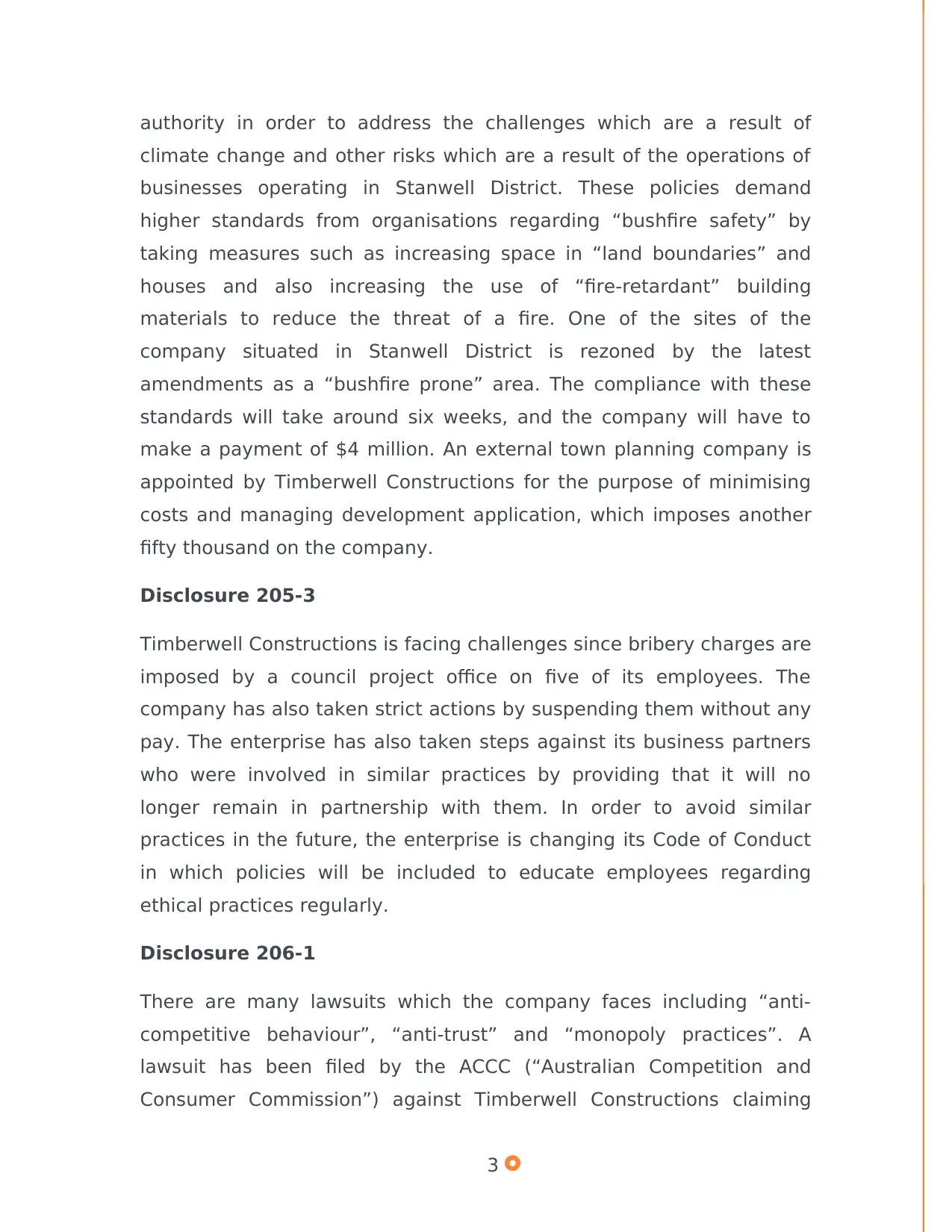
authority in order to address the challenges which are a result of
climate change and other risks which are a result of the operations of
businesses operating in Stanwell District. These policies demand
higher standards from organisations regarding “bushfire safety” by
taking measures such as increasing space in “land boundaries” and
houses and also increasing the use of “fire-retardant” building
materials to reduce the threat of a fire. One of the sites of the
company situated in Stanwell District is rezoned by the latest
amendments as a “bushfire prone” area. The compliance with these
standards will take around six weeks, and the company will have to
make a payment of $4 million. An external town planning company is
appointed by Timberwell Constructions for the purpose of minimising
costs and managing development application, which imposes another
fifty thousand on the company.
Disclosure 205-3
Timberwell Constructions is facing challenges since bribery charges are
imposed by a council project office on five of its employees. The
company has also taken strict actions by suspending them without any
pay. The enterprise has also taken steps against its business partners
who were involved in similar practices by providing that it will no
longer remain in partnership with them. In order to avoid similar
practices in the future, the enterprise is changing its Code of Conduct
in which policies will be included to educate employees regarding
ethical practices regularly.
Disclosure 206-1
There are many lawsuits which the company faces including “anti-
competitive behaviour”, “anti-trust” and “monopoly practices”. A
lawsuit has been filed by the ACCC (“Australian Competition and
Consumer Commission”) against Timberwell Constructions claiming
3
climate change and other risks which are a result of the operations of
businesses operating in Stanwell District. These policies demand
higher standards from organisations regarding “bushfire safety” by
taking measures such as increasing space in “land boundaries” and
houses and also increasing the use of “fire-retardant” building
materials to reduce the threat of a fire. One of the sites of the
company situated in Stanwell District is rezoned by the latest
amendments as a “bushfire prone” area. The compliance with these
standards will take around six weeks, and the company will have to
make a payment of $4 million. An external town planning company is
appointed by Timberwell Constructions for the purpose of minimising
costs and managing development application, which imposes another
fifty thousand on the company.
Disclosure 205-3
Timberwell Constructions is facing challenges since bribery charges are
imposed by a council project office on five of its employees. The
company has also taken strict actions by suspending them without any
pay. The enterprise has also taken steps against its business partners
who were involved in similar practices by providing that it will no
longer remain in partnership with them. In order to avoid similar
practices in the future, the enterprise is changing its Code of Conduct
in which policies will be included to educate employees regarding
ethical practices regularly.
Disclosure 206-1
There are many lawsuits which the company faces including “anti-
competitive behaviour”, “anti-trust” and “monopoly practices”. A
lawsuit has been filed by the ACCC (“Australian Competition and
Consumer Commission”) against Timberwell Constructions claiming
3
Paraphrase This Document
Need a fresh take? Get an instant paraphrase of this document with our AI Paraphraser
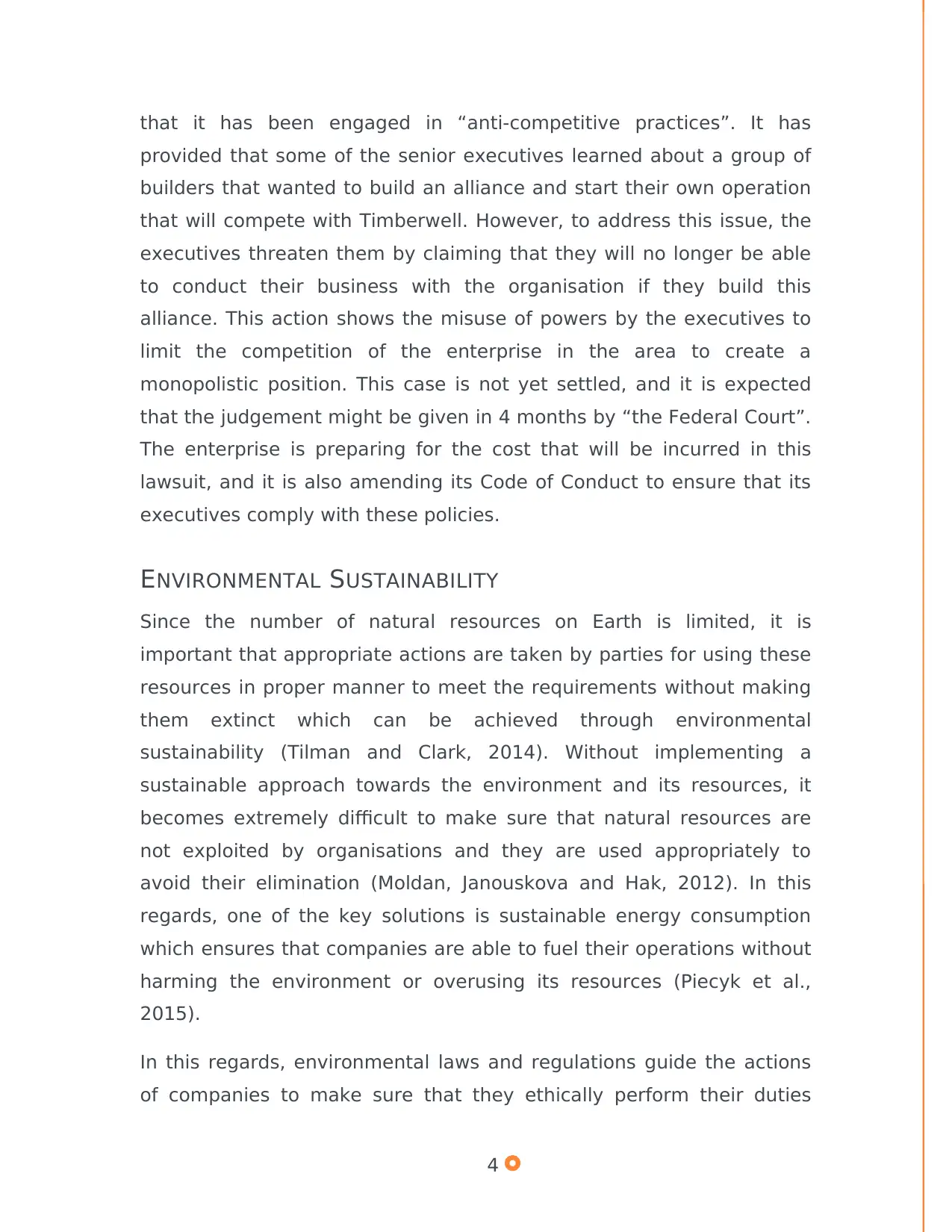
that it has been engaged in “anti-competitive practices”. It has
provided that some of the senior executives learned about a group of
builders that wanted to build an alliance and start their own operation
that will compete with Timberwell. However, to address this issue, the
executives threaten them by claiming that they will no longer be able
to conduct their business with the organisation if they build this
alliance. This action shows the misuse of powers by the executives to
limit the competition of the enterprise in the area to create a
monopolistic position. This case is not yet settled, and it is expected
that the judgement might be given in 4 months by “the Federal Court”.
The enterprise is preparing for the cost that will be incurred in this
lawsuit, and it is also amending its Code of Conduct to ensure that its
executives comply with these policies.
ENVIRONMENTAL SUSTAINABILITY
Since the number of natural resources on Earth is limited, it is
important that appropriate actions are taken by parties for using these
resources in proper manner to meet the requirements without making
them extinct which can be achieved through environmental
sustainability (Tilman and Clark, 2014). Without implementing a
sustainable approach towards the environment and its resources, it
becomes extremely difficult to make sure that natural resources are
not exploited by organisations and they are used appropriately to
avoid their elimination (Moldan, Janouskova and Hak, 2012). In this
regards, one of the key solutions is sustainable energy consumption
which ensures that companies are able to fuel their operations without
harming the environment or overusing its resources (Piecyk et al.,
2015).
In this regards, environmental laws and regulations guide the actions
of companies to make sure that they ethically perform their duties
4
provided that some of the senior executives learned about a group of
builders that wanted to build an alliance and start their own operation
that will compete with Timberwell. However, to address this issue, the
executives threaten them by claiming that they will no longer be able
to conduct their business with the organisation if they build this
alliance. This action shows the misuse of powers by the executives to
limit the competition of the enterprise in the area to create a
monopolistic position. This case is not yet settled, and it is expected
that the judgement might be given in 4 months by “the Federal Court”.
The enterprise is preparing for the cost that will be incurred in this
lawsuit, and it is also amending its Code of Conduct to ensure that its
executives comply with these policies.
ENVIRONMENTAL SUSTAINABILITY
Since the number of natural resources on Earth is limited, it is
important that appropriate actions are taken by parties for using these
resources in proper manner to meet the requirements without making
them extinct which can be achieved through environmental
sustainability (Tilman and Clark, 2014). Without implementing a
sustainable approach towards the environment and its resources, it
becomes extremely difficult to make sure that natural resources are
not exploited by organisations and they are used appropriately to
avoid their elimination (Moldan, Janouskova and Hak, 2012). In this
regards, one of the key solutions is sustainable energy consumption
which ensures that companies are able to fuel their operations without
harming the environment or overusing its resources (Piecyk et al.,
2015).
In this regards, environmental laws and regulations guide the actions
of companies to make sure that they ethically perform their duties
4
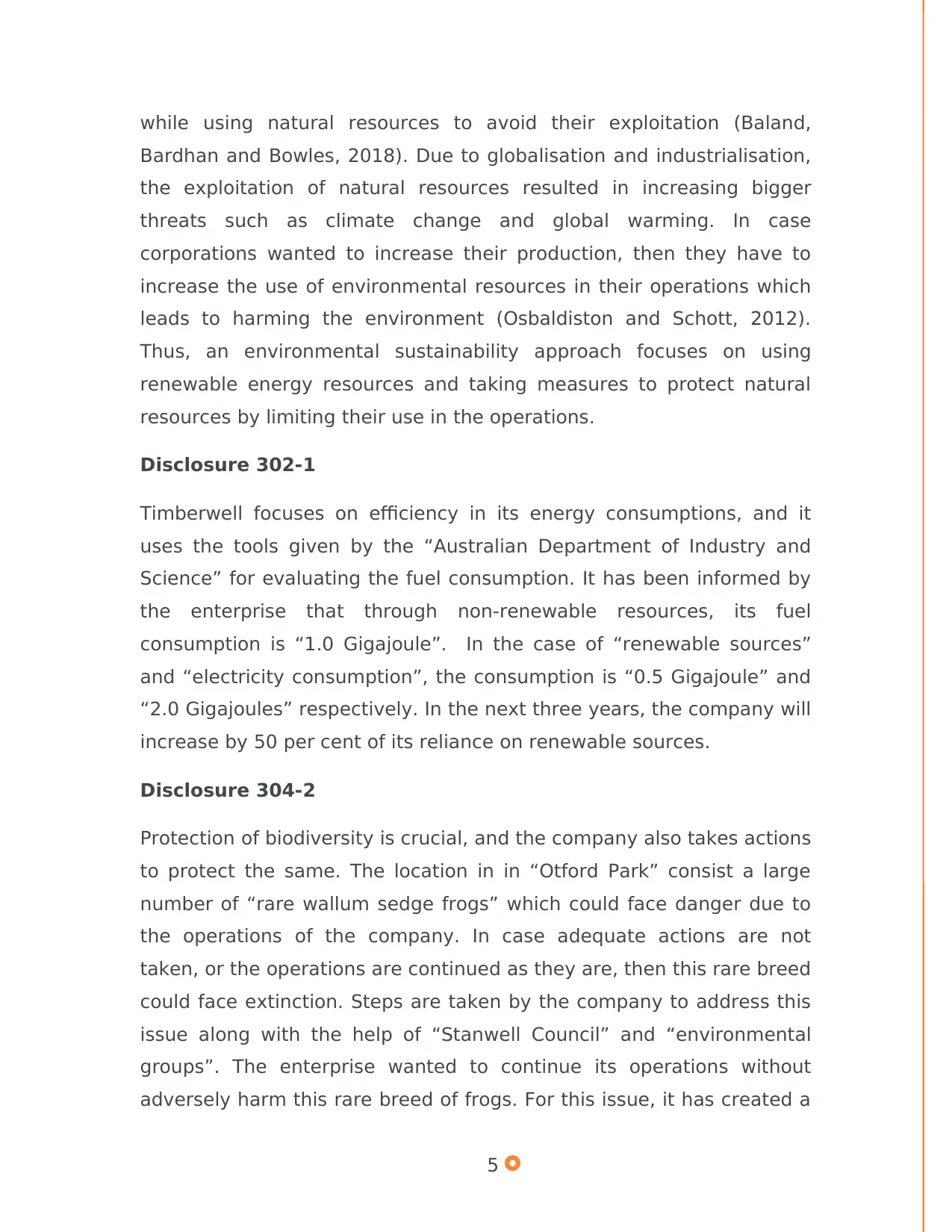
while using natural resources to avoid their exploitation (Baland,
Bardhan and Bowles, 2018). Due to globalisation and industrialisation,
the exploitation of natural resources resulted in increasing bigger
threats such as climate change and global warming. In case
corporations wanted to increase their production, then they have to
increase the use of environmental resources in their operations which
leads to harming the environment (Osbaldiston and Schott, 2012).
Thus, an environmental sustainability approach focuses on using
renewable energy resources and taking measures to protect natural
resources by limiting their use in the operations.
Disclosure 302-1
Timberwell focuses on efficiency in its energy consumptions, and it
uses the tools given by the “Australian Department of Industry and
Science” for evaluating the fuel consumption. It has been informed by
the enterprise that through non-renewable resources, its fuel
consumption is “1.0 Gigajoule”. In the case of “renewable sources”
and “electricity consumption”, the consumption is “0.5 Gigajoule” and
“2.0 Gigajoules” respectively. In the next three years, the company will
increase by 50 per cent of its reliance on renewable sources.
Disclosure 304-2
Protection of biodiversity is crucial, and the company also takes actions
to protect the same. The location in in “Otford Park” consist a large
number of “rare wallum sedge frogs” which could face danger due to
the operations of the company. In case adequate actions are not
taken, or the operations are continued as they are, then this rare breed
could face extinction. Steps are taken by the company to address this
issue along with the help of “Stanwell Council” and “environmental
groups”. The enterprise wanted to continue its operations without
adversely harm this rare breed of frogs. For this issue, it has created a
5
Bardhan and Bowles, 2018). Due to globalisation and industrialisation,
the exploitation of natural resources resulted in increasing bigger
threats such as climate change and global warming. In case
corporations wanted to increase their production, then they have to
increase the use of environmental resources in their operations which
leads to harming the environment (Osbaldiston and Schott, 2012).
Thus, an environmental sustainability approach focuses on using
renewable energy resources and taking measures to protect natural
resources by limiting their use in the operations.
Disclosure 302-1
Timberwell focuses on efficiency in its energy consumptions, and it
uses the tools given by the “Australian Department of Industry and
Science” for evaluating the fuel consumption. It has been informed by
the enterprise that through non-renewable resources, its fuel
consumption is “1.0 Gigajoule”. In the case of “renewable sources”
and “electricity consumption”, the consumption is “0.5 Gigajoule” and
“2.0 Gigajoules” respectively. In the next three years, the company will
increase by 50 per cent of its reliance on renewable sources.
Disclosure 304-2
Protection of biodiversity is crucial, and the company also takes actions
to protect the same. The location in in “Otford Park” consist a large
number of “rare wallum sedge frogs” which could face danger due to
the operations of the company. In case adequate actions are not
taken, or the operations are continued as they are, then this rare breed
could face extinction. Steps are taken by the company to address this
issue along with the help of “Stanwell Council” and “environmental
groups”. The enterprise wanted to continue its operations without
adversely harm this rare breed of frogs. For this issue, it has created a
5
⊘ This is a preview!⊘
Do you want full access?
Subscribe today to unlock all pages.

Trusted by 1+ million students worldwide
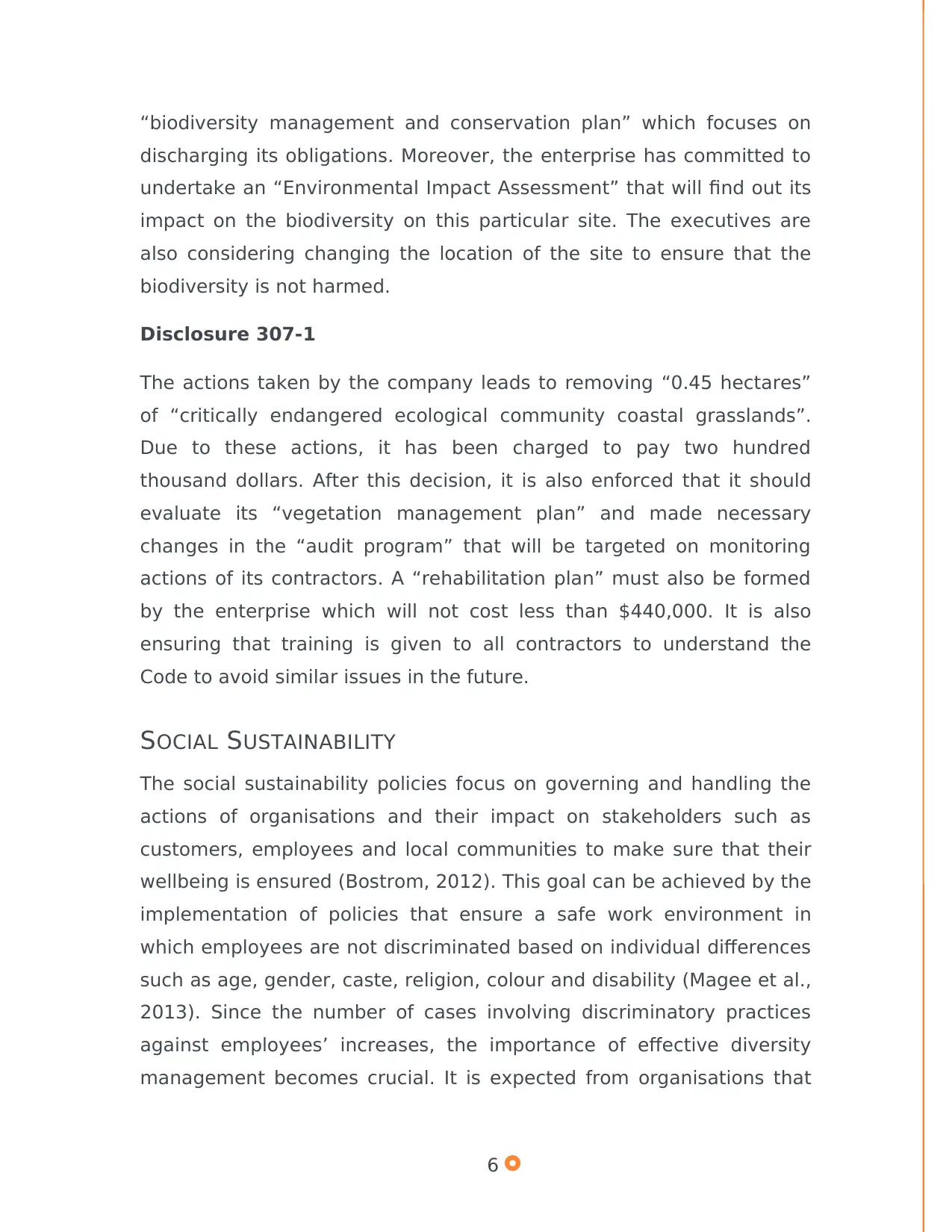
“biodiversity management and conservation plan” which focuses on
discharging its obligations. Moreover, the enterprise has committed to
undertake an “Environmental Impact Assessment” that will find out its
impact on the biodiversity on this particular site. The executives are
also considering changing the location of the site to ensure that the
biodiversity is not harmed.
Disclosure 307-1
The actions taken by the company leads to removing “0.45 hectares”
of “critically endangered ecological community coastal grasslands”.
Due to these actions, it has been charged to pay two hundred
thousand dollars. After this decision, it is also enforced that it should
evaluate its “vegetation management plan” and made necessary
changes in the “audit program” that will be targeted on monitoring
actions of its contractors. A “rehabilitation plan” must also be formed
by the enterprise which will not cost less than $440,000. It is also
ensuring that training is given to all contractors to understand the
Code to avoid similar issues in the future.
SOCIAL SUSTAINABILITY
The social sustainability policies focus on governing and handling the
actions of organisations and their impact on stakeholders such as
customers, employees and local communities to make sure that their
wellbeing is ensured (Bostrom, 2012). This goal can be achieved by the
implementation of policies that ensure a safe work environment in
which employees are not discriminated based on individual differences
such as age, gender, caste, religion, colour and disability (Magee et al.,
2013). Since the number of cases involving discriminatory practices
against employees’ increases, the importance of effective diversity
management becomes crucial. It is expected from organisations that
6
discharging its obligations. Moreover, the enterprise has committed to
undertake an “Environmental Impact Assessment” that will find out its
impact on the biodiversity on this particular site. The executives are
also considering changing the location of the site to ensure that the
biodiversity is not harmed.
Disclosure 307-1
The actions taken by the company leads to removing “0.45 hectares”
of “critically endangered ecological community coastal grasslands”.
Due to these actions, it has been charged to pay two hundred
thousand dollars. After this decision, it is also enforced that it should
evaluate its “vegetation management plan” and made necessary
changes in the “audit program” that will be targeted on monitoring
actions of its contractors. A “rehabilitation plan” must also be formed
by the enterprise which will not cost less than $440,000. It is also
ensuring that training is given to all contractors to understand the
Code to avoid similar issues in the future.
SOCIAL SUSTAINABILITY
The social sustainability policies focus on governing and handling the
actions of organisations and their impact on stakeholders such as
customers, employees and local communities to make sure that their
wellbeing is ensured (Bostrom, 2012). This goal can be achieved by the
implementation of policies that ensure a safe work environment in
which employees are not discriminated based on individual differences
such as age, gender, caste, religion, colour and disability (Magee et al.,
2013). Since the number of cases involving discriminatory practices
against employees’ increases, the importance of effective diversity
management becomes crucial. It is expected from organisations that
6
Paraphrase This Document
Need a fresh take? Get an instant paraphrase of this document with our AI Paraphraser
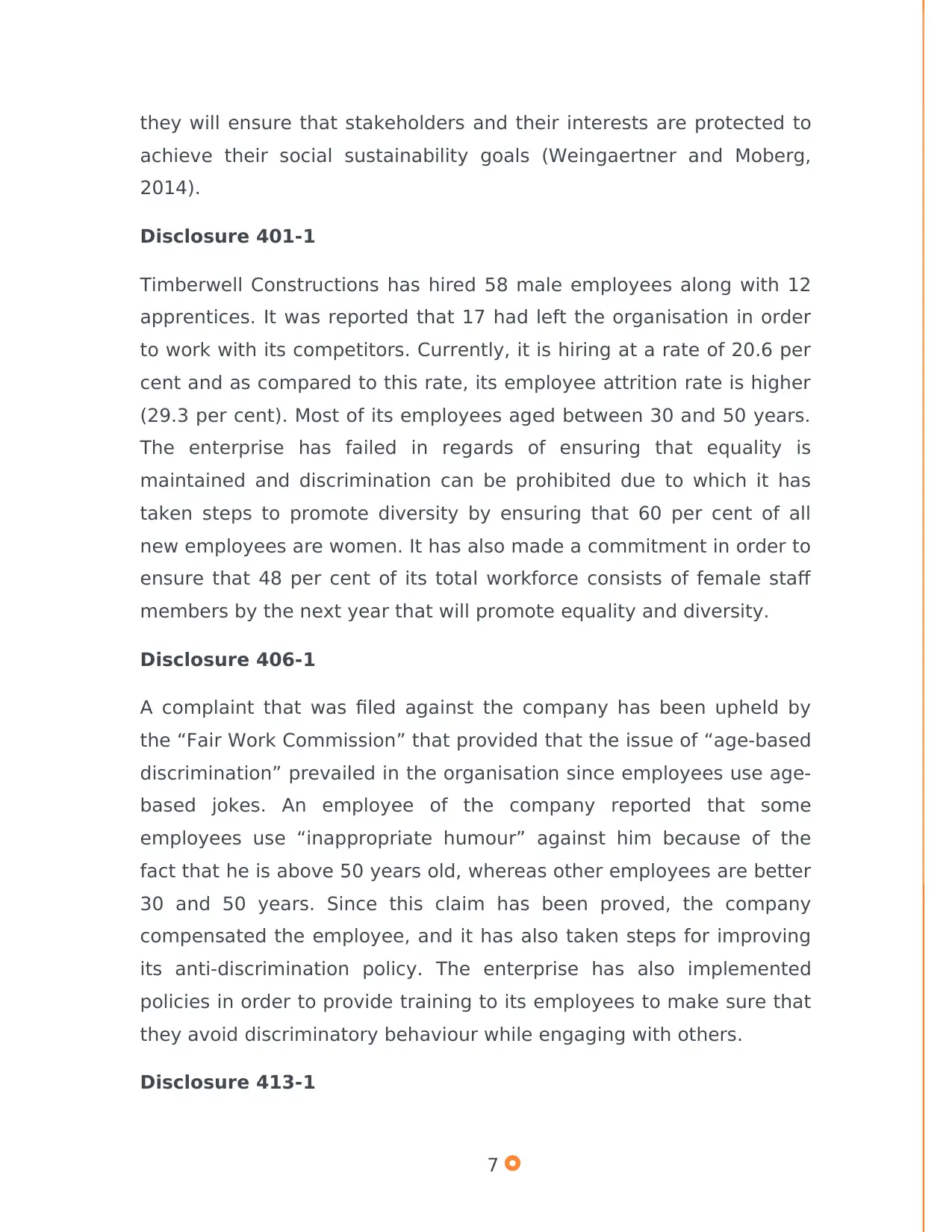
they will ensure that stakeholders and their interests are protected to
achieve their social sustainability goals (Weingaertner and Moberg,
2014).
Disclosure 401-1
Timberwell Constructions has hired 58 male employees along with 12
apprentices. It was reported that 17 had left the organisation in order
to work with its competitors. Currently, it is hiring at a rate of 20.6 per
cent and as compared to this rate, its employee attrition rate is higher
(29.3 per cent). Most of its employees aged between 30 and 50 years.
The enterprise has failed in regards of ensuring that equality is
maintained and discrimination can be prohibited due to which it has
taken steps to promote diversity by ensuring that 60 per cent of all
new employees are women. It has also made a commitment in order to
ensure that 48 per cent of its total workforce consists of female staff
members by the next year that will promote equality and diversity.
Disclosure 406-1
A complaint that was filed against the company has been upheld by
the “Fair Work Commission” that provided that the issue of “age-based
discrimination” prevailed in the organisation since employees use age-
based jokes. An employee of the company reported that some
employees use “inappropriate humour” against him because of the
fact that he is above 50 years old, whereas other employees are better
30 and 50 years. Since this claim has been proved, the company
compensated the employee, and it has also taken steps for improving
its anti-discrimination policy. The enterprise has also implemented
policies in order to provide training to its employees to make sure that
they avoid discriminatory behaviour while engaging with others.
Disclosure 413-1
7
achieve their social sustainability goals (Weingaertner and Moberg,
2014).
Disclosure 401-1
Timberwell Constructions has hired 58 male employees along with 12
apprentices. It was reported that 17 had left the organisation in order
to work with its competitors. Currently, it is hiring at a rate of 20.6 per
cent and as compared to this rate, its employee attrition rate is higher
(29.3 per cent). Most of its employees aged between 30 and 50 years.
The enterprise has failed in regards of ensuring that equality is
maintained and discrimination can be prohibited due to which it has
taken steps to promote diversity by ensuring that 60 per cent of all
new employees are women. It has also made a commitment in order to
ensure that 48 per cent of its total workforce consists of female staff
members by the next year that will promote equality and diversity.
Disclosure 406-1
A complaint that was filed against the company has been upheld by
the “Fair Work Commission” that provided that the issue of “age-based
discrimination” prevailed in the organisation since employees use age-
based jokes. An employee of the company reported that some
employees use “inappropriate humour” against him because of the
fact that he is above 50 years old, whereas other employees are better
30 and 50 years. Since this claim has been proved, the company
compensated the employee, and it has also taken steps for improving
its anti-discrimination policy. The enterprise has also implemented
policies in order to provide training to its employees to make sure that
they avoid discriminatory behaviour while engaging with others.
Disclosure 413-1
7
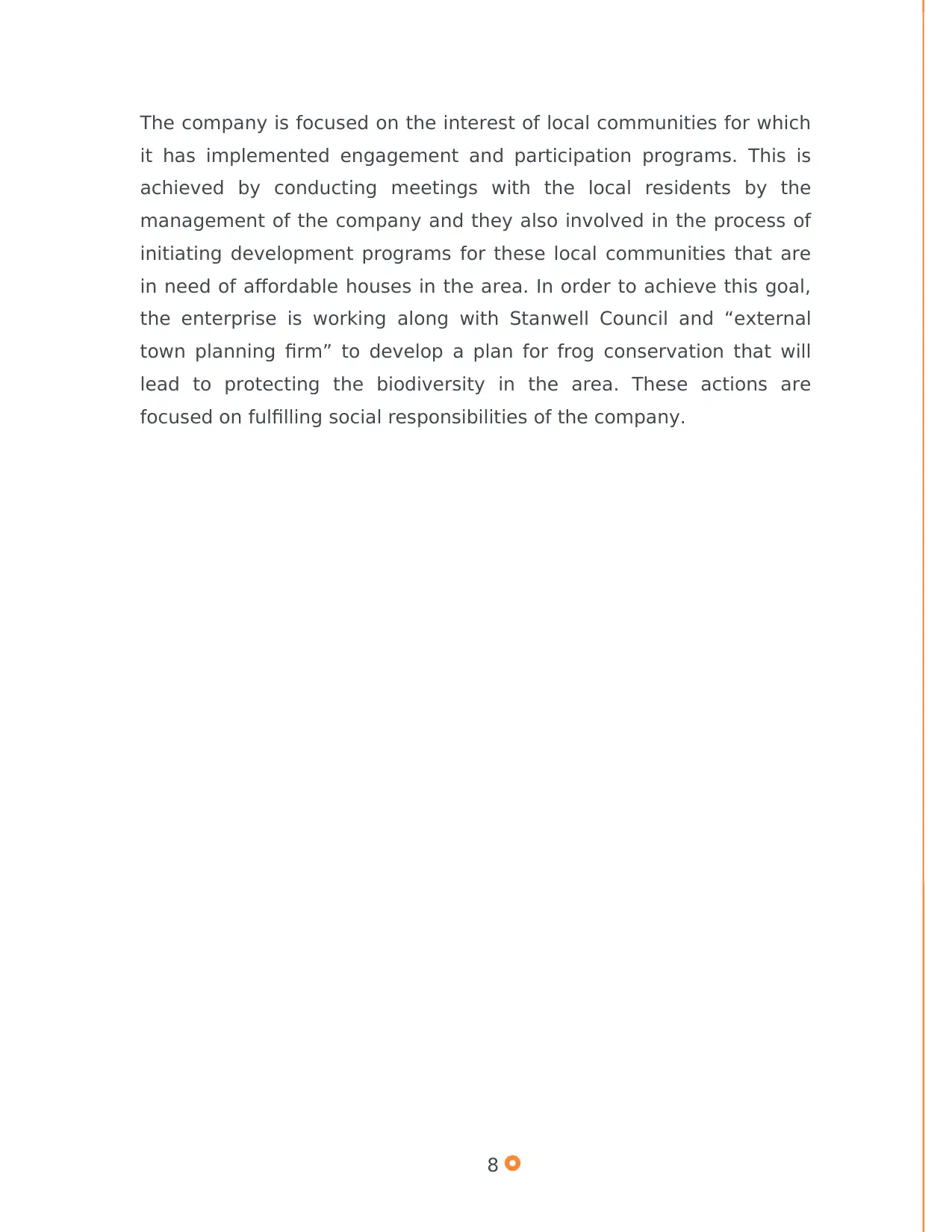
The company is focused on the interest of local communities for which
it has implemented engagement and participation programs. This is
achieved by conducting meetings with the local residents by the
management of the company and they also involved in the process of
initiating development programs for these local communities that are
in need of affordable houses in the area. In order to achieve this goal,
the enterprise is working along with Stanwell Council and “external
town planning firm” to develop a plan for frog conservation that will
lead to protecting the biodiversity in the area. These actions are
focused on fulfilling social responsibilities of the company.
8
it has implemented engagement and participation programs. This is
achieved by conducting meetings with the local residents by the
management of the company and they also involved in the process of
initiating development programs for these local communities that are
in need of affordable houses in the area. In order to achieve this goal,
the enterprise is working along with Stanwell Council and “external
town planning firm” to develop a plan for frog conservation that will
lead to protecting the biodiversity in the area. These actions are
focused on fulfilling social responsibilities of the company.
8
⊘ This is a preview!⊘
Do you want full access?
Subscribe today to unlock all pages.

Trusted by 1+ million students worldwide
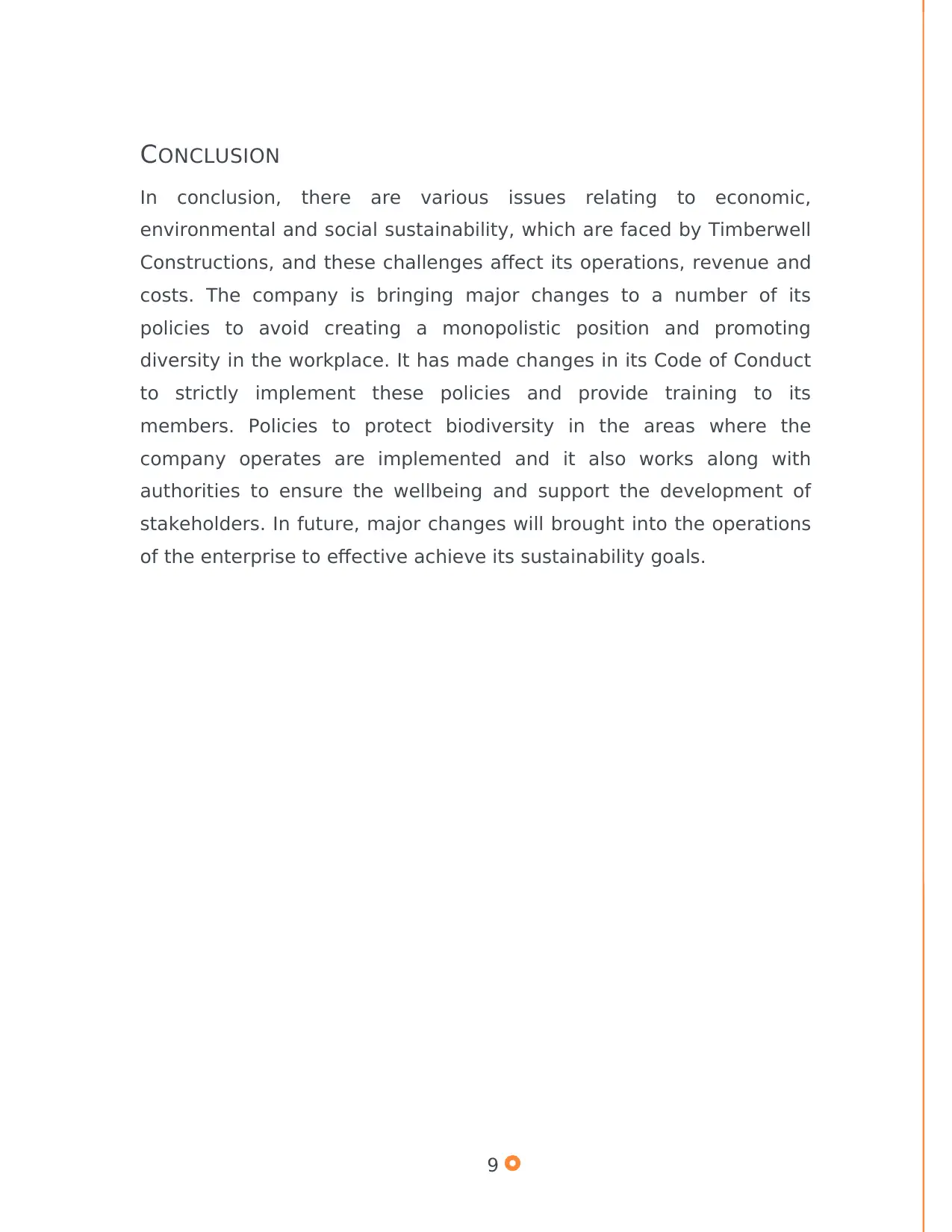
CONCLUSION
In conclusion, there are various issues relating to economic,
environmental and social sustainability, which are faced by Timberwell
Constructions, and these challenges affect its operations, revenue and
costs. The company is bringing major changes to a number of its
policies to avoid creating a monopolistic position and promoting
diversity in the workplace. It has made changes in its Code of Conduct
to strictly implement these policies and provide training to its
members. Policies to protect biodiversity in the areas where the
company operates are implemented and it also works along with
authorities to ensure the wellbeing and support the development of
stakeholders. In future, major changes will brought into the operations
of the enterprise to effective achieve its sustainability goals.
9
In conclusion, there are various issues relating to economic,
environmental and social sustainability, which are faced by Timberwell
Constructions, and these challenges affect its operations, revenue and
costs. The company is bringing major changes to a number of its
policies to avoid creating a monopolistic position and promoting
diversity in the workplace. It has made changes in its Code of Conduct
to strictly implement these policies and provide training to its
members. Policies to protect biodiversity in the areas where the
company operates are implemented and it also works along with
authorities to ensure the wellbeing and support the development of
stakeholders. In future, major changes will brought into the operations
of the enterprise to effective achieve its sustainability goals.
9
Paraphrase This Document
Need a fresh take? Get an instant paraphrase of this document with our AI Paraphraser
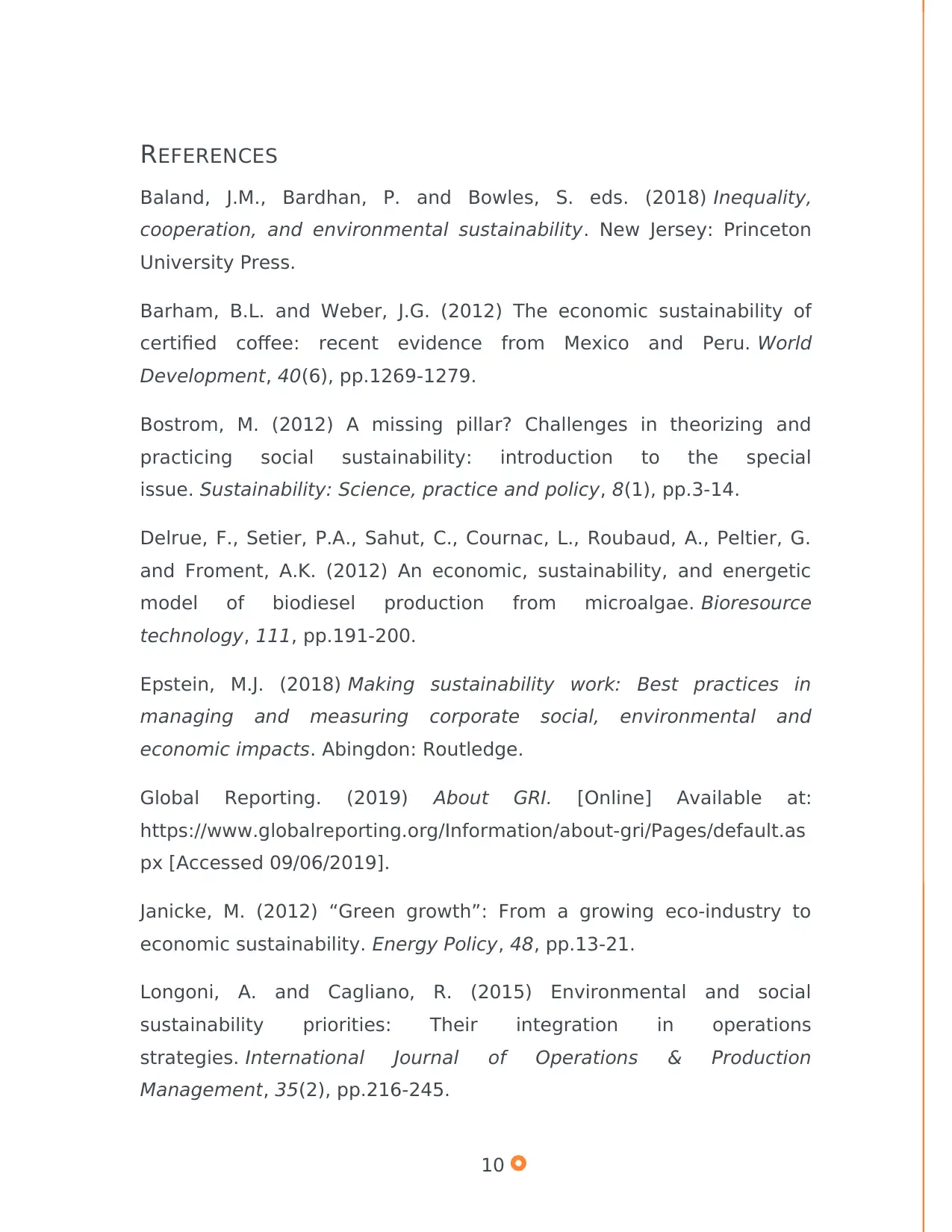
REFERENCES
Baland, J.M., Bardhan, P. and Bowles, S. eds. (2018) Inequality,
cooperation, and environmental sustainability. New Jersey: Princeton
University Press.
Barham, B.L. and Weber, J.G. (2012) The economic sustainability of
certified coffee: recent evidence from Mexico and Peru. World
Development, 40(6), pp.1269-1279.
Bostrom, M. (2012) A missing pillar? Challenges in theorizing and
practicing social sustainability: introduction to the special
issue. Sustainability: Science, practice and policy, 8(1), pp.3-14.
Delrue, F., Setier, P.A., Sahut, C., Cournac, L., Roubaud, A., Peltier, G.
and Froment, A.K. (2012) An economic, sustainability, and energetic
model of biodiesel production from microalgae. Bioresource
technology, 111, pp.191-200.
Epstein, M.J. (2018) Making sustainability work: Best practices in
managing and measuring corporate social, environmental and
economic impacts. Abingdon: Routledge.
Global Reporting. (2019) About GRI. [Online] Available at:
https://www.globalreporting.org/Information/about-gri/Pages/default.as
px [Accessed 09/06/2019].
Janicke, M. (2012) “Green growth”: From a growing eco-industry to
economic sustainability. Energy Policy, 48, pp.13-21.
Longoni, A. and Cagliano, R. (2015) Environmental and social
sustainability priorities: Their integration in operations
strategies. International Journal of Operations & Production
Management, 35(2), pp.216-245.
10
Baland, J.M., Bardhan, P. and Bowles, S. eds. (2018) Inequality,
cooperation, and environmental sustainability. New Jersey: Princeton
University Press.
Barham, B.L. and Weber, J.G. (2012) The economic sustainability of
certified coffee: recent evidence from Mexico and Peru. World
Development, 40(6), pp.1269-1279.
Bostrom, M. (2012) A missing pillar? Challenges in theorizing and
practicing social sustainability: introduction to the special
issue. Sustainability: Science, practice and policy, 8(1), pp.3-14.
Delrue, F., Setier, P.A., Sahut, C., Cournac, L., Roubaud, A., Peltier, G.
and Froment, A.K. (2012) An economic, sustainability, and energetic
model of biodiesel production from microalgae. Bioresource
technology, 111, pp.191-200.
Epstein, M.J. (2018) Making sustainability work: Best practices in
managing and measuring corporate social, environmental and
economic impacts. Abingdon: Routledge.
Global Reporting. (2019) About GRI. [Online] Available at:
https://www.globalreporting.org/Information/about-gri/Pages/default.as
px [Accessed 09/06/2019].
Janicke, M. (2012) “Green growth”: From a growing eco-industry to
economic sustainability. Energy Policy, 48, pp.13-21.
Longoni, A. and Cagliano, R. (2015) Environmental and social
sustainability priorities: Their integration in operations
strategies. International Journal of Operations & Production
Management, 35(2), pp.216-245.
10
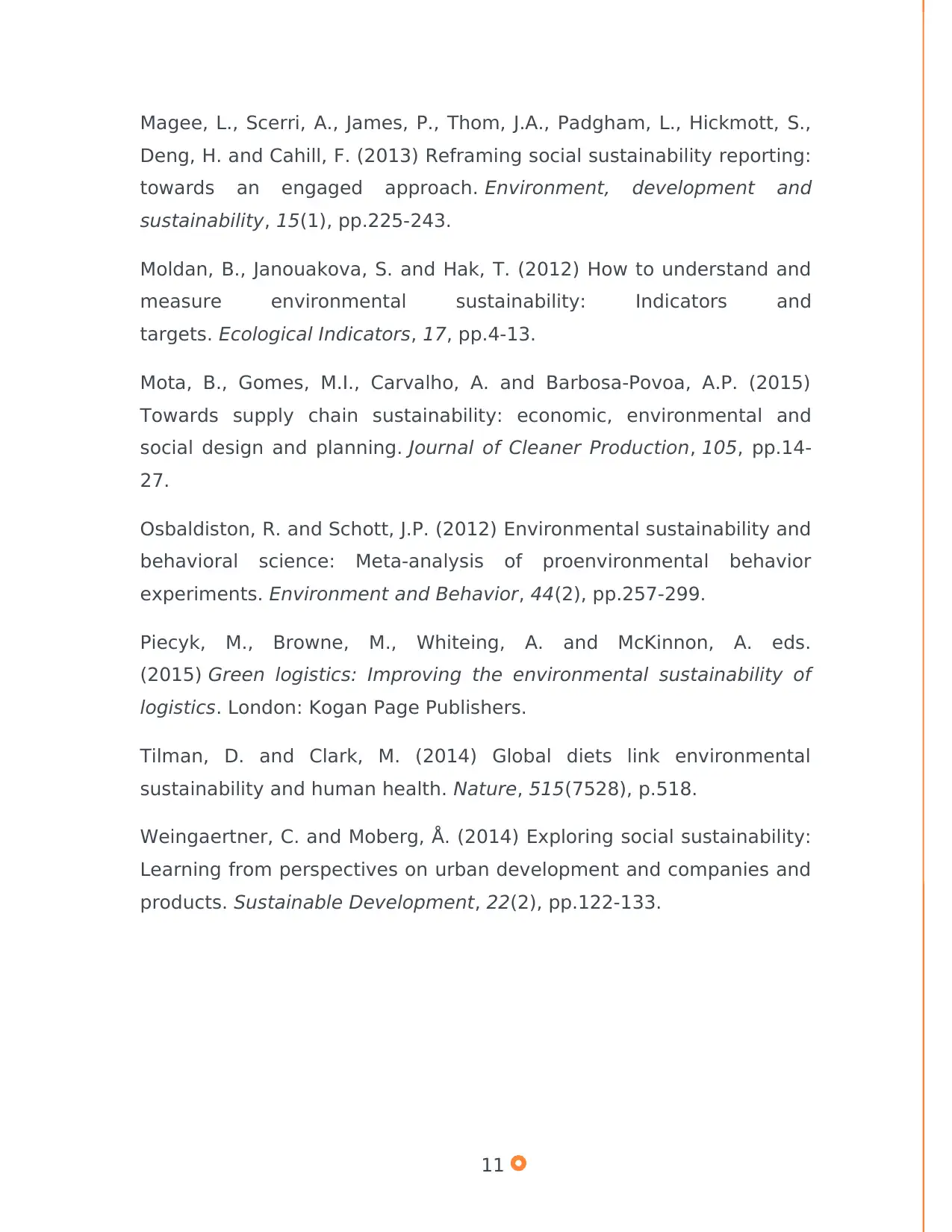
Magee, L., Scerri, A., James, P., Thom, J.A., Padgham, L., Hickmott, S.,
Deng, H. and Cahill, F. (2013) Reframing social sustainability reporting:
towards an engaged approach. Environment, development and
sustainability, 15(1), pp.225-243.
Moldan, B., Janouakova, S. and Hak, T. (2012) How to understand and
measure environmental sustainability: Indicators and
targets. Ecological Indicators, 17, pp.4-13.
Mota, B., Gomes, M.I., Carvalho, A. and Barbosa-Povoa, A.P. (2015)
Towards supply chain sustainability: economic, environmental and
social design and planning. Journal of Cleaner Production, 105, pp.14-
27.
Osbaldiston, R. and Schott, J.P. (2012) Environmental sustainability and
behavioral science: Meta-analysis of proenvironmental behavior
experiments. Environment and Behavior, 44(2), pp.257-299.
Piecyk, M., Browne, M., Whiteing, A. and McKinnon, A. eds.
(2015) Green logistics: Improving the environmental sustainability of
logistics. London: Kogan Page Publishers.
Tilman, D. and Clark, M. (2014) Global diets link environmental
sustainability and human health. Nature, 515(7528), p.518.
Weingaertner, C. and Moberg, Å. (2014) Exploring social sustainability:
Learning from perspectives on urban development and companies and
products. Sustainable Development, 22(2), pp.122-133.
11
Deng, H. and Cahill, F. (2013) Reframing social sustainability reporting:
towards an engaged approach. Environment, development and
sustainability, 15(1), pp.225-243.
Moldan, B., Janouakova, S. and Hak, T. (2012) How to understand and
measure environmental sustainability: Indicators and
targets. Ecological Indicators, 17, pp.4-13.
Mota, B., Gomes, M.I., Carvalho, A. and Barbosa-Povoa, A.P. (2015)
Towards supply chain sustainability: economic, environmental and
social design and planning. Journal of Cleaner Production, 105, pp.14-
27.
Osbaldiston, R. and Schott, J.P. (2012) Environmental sustainability and
behavioral science: Meta-analysis of proenvironmental behavior
experiments. Environment and Behavior, 44(2), pp.257-299.
Piecyk, M., Browne, M., Whiteing, A. and McKinnon, A. eds.
(2015) Green logistics: Improving the environmental sustainability of
logistics. London: Kogan Page Publishers.
Tilman, D. and Clark, M. (2014) Global diets link environmental
sustainability and human health. Nature, 515(7528), p.518.
Weingaertner, C. and Moberg, Å. (2014) Exploring social sustainability:
Learning from perspectives on urban development and companies and
products. Sustainable Development, 22(2), pp.122-133.
11
⊘ This is a preview!⊘
Do you want full access?
Subscribe today to unlock all pages.

Trusted by 1+ million students worldwide
1 out of 12
Related Documents
Your All-in-One AI-Powered Toolkit for Academic Success.
+13062052269
info@desklib.com
Available 24*7 on WhatsApp / Email
![[object Object]](/_next/static/media/star-bottom.7253800d.svg)
Unlock your academic potential
Copyright © 2020–2025 A2Z Services. All Rights Reserved. Developed and managed by ZUCOL.





